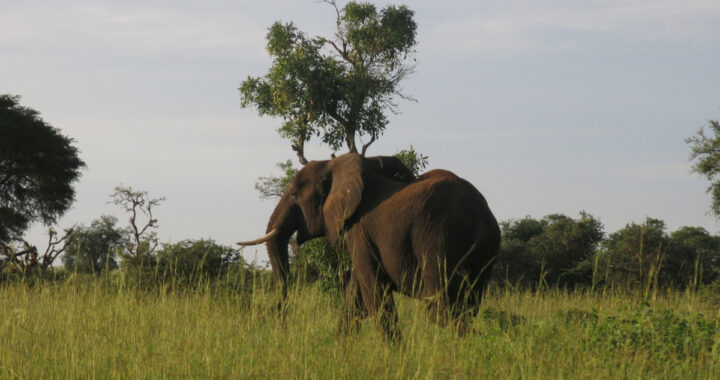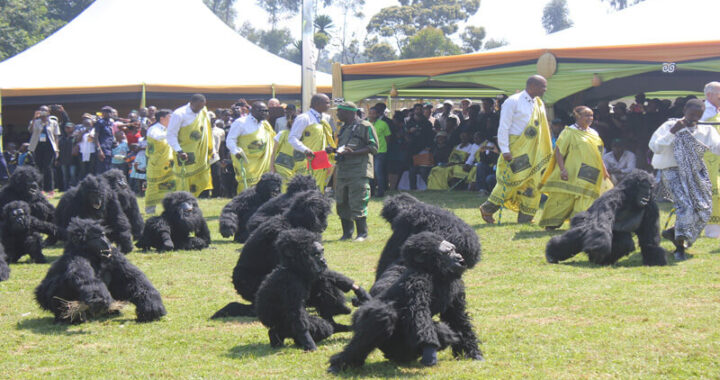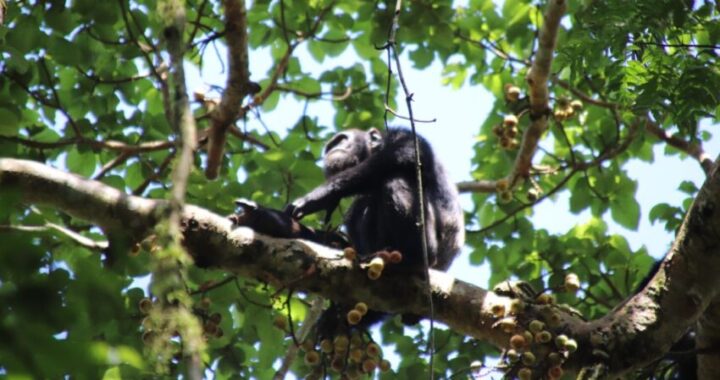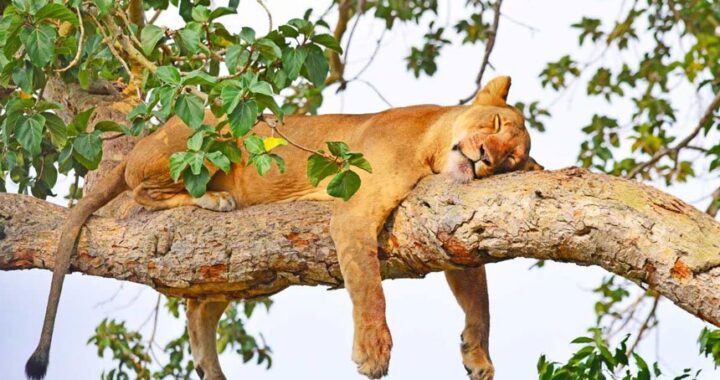Wildlife conservation projects in Uganda are given prominence when the country joins the rest of the world to celebrate annual World Wildlife Day. This year’s theme is “Partnerships for Wildlife Conservation,” and it explores the interactions and roles of different industry actors towards conservation.
These including the private sector, businesses, government, and non-governmental organizations, policy makers, and local communities. World Wildlife Day occurs on 3 March every year and was established by the United Nations General Assembly in 2013. The date was selected to honor the signing of the Convention on International Trade in Endangered Species of Wildlife and Flora (CITES) which occurred on 3rd March in 1973. Uganda is a member of this agreement that brings together governments from 184 countries to prevent the illegal trade of wildlife species.
Wildlife conservation according to National Geographic (NAT GEO), is a practice of protecting wild flora and fauna species in their natural habitats. Threats to wildlife including habitat loss, climate change, pollution, illegal wildlife trade, and diseases are responsible for putting over 1 million species at risk of extinction due to degradation of ecosystems according to Flora and Fauna International (FFI) recent conservation report. Depending on how serious the threat is to a given species, a species is categorized as Vulnerable, Near Threatened, Endangered, or Critically Endangered. The conservation status of various species is maintained by the International Union for Conservation of Nature (IUCN) Red List of Endangered Species.
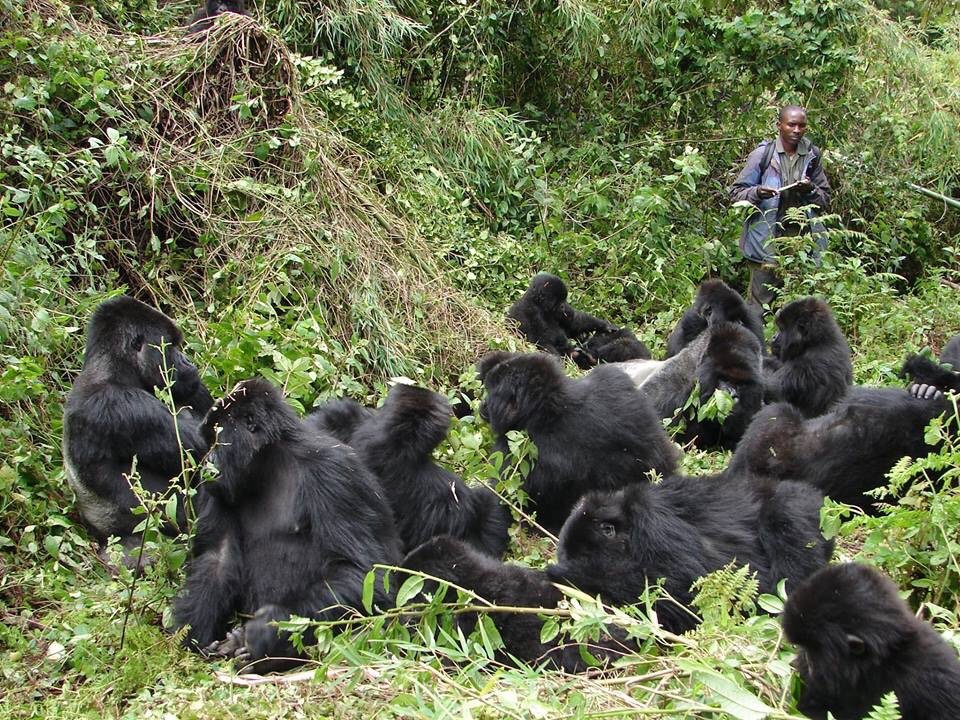
Unfortunately, many of Uganda’s wildlife species fit into these categories, including the endangered mountain gorillas and chimpanzees. The critically endangered golden monkeys, elephants, and grey crowned crane (national bird). Lions and cheetahs are vulnerable. This has inspired several environmental and conservation initiatives in Uganda to conserve biodiversity.
Those planning to travel to Uganda can participate in some of the unique wildlife and cultural conservation experiences including lion research, coffee safaris, gorilla and chimpanzee trekking. Some of the projects involve hands-on experience such as collection of information through photography, field surveys, and tracking animals in the wild. Volunteering opportunities are also available for booking through tour operators who will help you to plan and decide which opportunities most appeal to you. We have put together a list of non-profit organizations, wildlife research and conservation projects that you can check out and become part of while on your safari in Uganda.
The Uganda travel offerings
Tourism in Uganda is based on nature and wildlife which means that conservation is paramount. The industry is government aided and private sector led. There are several stakeholders involved in the tourism value chain including 937 licensed tour guides, over 3,879 participants in the accommodation, and 1,111 tour operators.
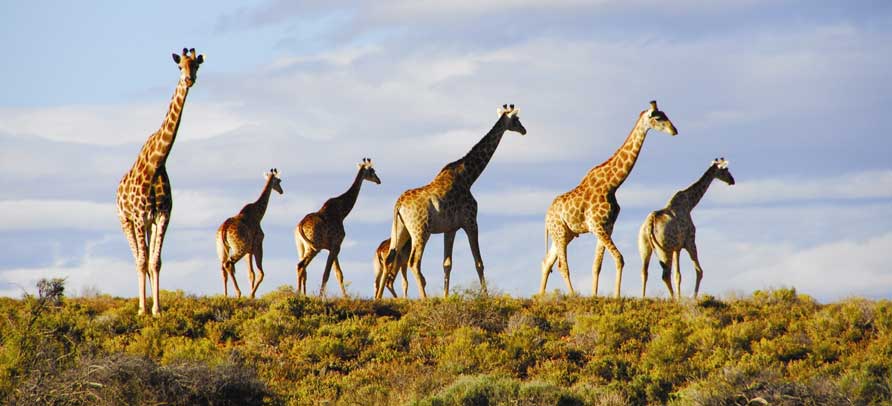
The Ministry of Tourism, Wildlife and Antiquities (MTWA) report of 2019 indicates that prior to the COVID-19 pandemic, Uganda’s economy benefited directly from travel and tourism to the tune of $1.37 billion or 5,093 billion Uganda Shillings which was almost 3.64% of the total growth national product (GDP). Additionally, more than 1.5 million jobs were provided, of which 2 in 10 Ugandans worked in tourism.
The government supports tourism industry stakeholders in a number of ways, including the quality assurance and product diversification. This has led to a shift in Uganda safaris away from traditional travel offers. Through domestic tourism campaigns #ExploreUganda and partnerships that bring together nature, culture, people, artists and brands to achieve the best sustainable practices and provide high-quality services while promoting Uganda further as the best in East Africa. You will find unique cultural and wildlife experiences as well as research tours, filming and documentary, mountain climbing, running with Uganda’s champions in Kapchorwa among others.
Conservation through public health
Creating opportunities for people to coexist with wildlife including mountain gorillas is the mission of the local non-profit group Conservation through Public Health (CTPH). The project works to address the economic and health issues affecting the local communities living around Bwindi impenetrable national park and other Uganda’s protected areas such as Virunga, Mount Elgon, Pian Upe and Queen Elizabeth national parks.
Dr. Gladys Kalema, who founded CTPH in 2003 formerly worked with Uganda Wildlife Authority (UWA) as a wildlife veterinary doctor and conservationist. Her dedication for protecting wildlife through one health approach that recognizes the interdependence between wildlife, people and the environment has won her several international accolades including the San Diego Zoo Conservation in Action award (2008). CTPH headquarters are located in the Buhoma gorilla sector of Bwindi Forest, home to 459 gorillas which is almost half of the 1,063-world mountain gorilla population. Gorilla population is continuously increasing yet the size of the forest never expands accordingly. The primates know no boundaries and sometimes escape into the people’s farmlands.
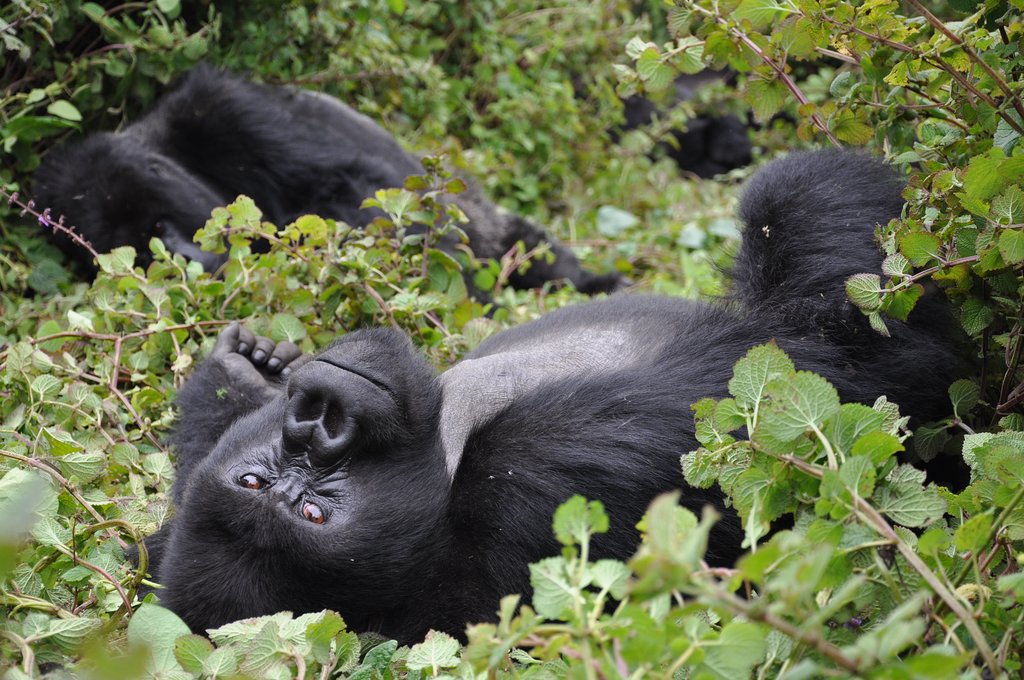
Gorillas share 98% of their DNA with people and are at risk of contracting infectious diseases influenza, Ebola, and Covid-19 when they come into contact with human or domestic waste. In this regard, CTPH works to provide solutions by monitoring the health of both gorillas and their environment. They do their work in partnership with Village Health and Conservation Teams (VHCTs), gorilla doctors, UWA and Bwindi Community Hospital.
When you come for gorilla trekking, you can get involved and support their work. CTPH offers opportunities for volunteering, internship, research support at the Gorilla Health Institute in Buhoma which also has accommodation at the Gorilla Conservation Camp. In addition, CTPH also supports coffee farmers through the gorilla coffee conservation safari – a project that supports local farmers by facilitating their farming skills and purchasing their beans at premium price. A coffee safari offers a chance to learn how coffee is grown and harvested. All proceeds go to support CTPH work to save gorillas and improve livelihoods.
Rhino fund project
Both the southern and eastern black rhino species were once found in Uganda’s protected areas including Murchison falls and Kidepo national parks. Sadly, the last black rhino in Uganda was seen in the Narus valley in Kidepo in the 1980s. Under Section 45 of the Uganda Wildlife Act, 2019, the Uganda Rhino Fund (RFU), a non governmental organization was created in 1997 and a 7,000 sq. hectare Ziwa rhino sanctuary in 2005 in Nakasongola district, 86 km northwest of Kampala capital city.
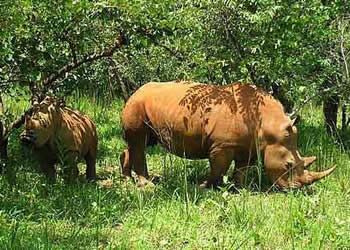
With support from Chester Zoo and Kenya, 5 white rhinos were shipped and put into the natural wilderness that has a wall electric fence around it and is secured by the UWA rangers. With over 33 rhinos present today, the number of rhinos has increased over time, proving the success of the wildlife conservation projects in Uganda. When the sanctuary’s rhino population has grown to it’s carrying capability, the rhinos will be released back into the wild. RFU operates on privately owned land which is financially challenging to sustain the land use rights, thus visiting the sanctuary contributes to the survival of rhinos in Uganda. Ziwa rhino sanctuary offers an opportunity to see rhinos through the on-foot rhino trekking experience. In addition, you can search for the shoebill stork tour and stay at accommodation facilities including Ziwa Rhino Campsite and Amuka lodge that are available for booking through the tour operator.
Experiential lion tracking and research
Lion tracking is available in Queen Elizabeth national park northern sector called Kasenyi plains where UWA visitor information centre is located along Mweya peninsular on the Kazinga channel. The protected area is rich in biodiversity including over 600 species of birds, big 4 mammals including elephant, buffalo, leopard and lions as well as hippos, and chimpanzees.
One of the main tourist attractions for visitors to the park are lions including the famous Ishasha tree climbing lions in the southern sector. The park is home to over 200 of the estimated 400 Uganda lion population according to Wildlife Conservation Society of Uganda (UWCS). Lions in Queen Elizabeth national park are not only unique for their tree climbing character but are also dying due to human wildlife conflict.
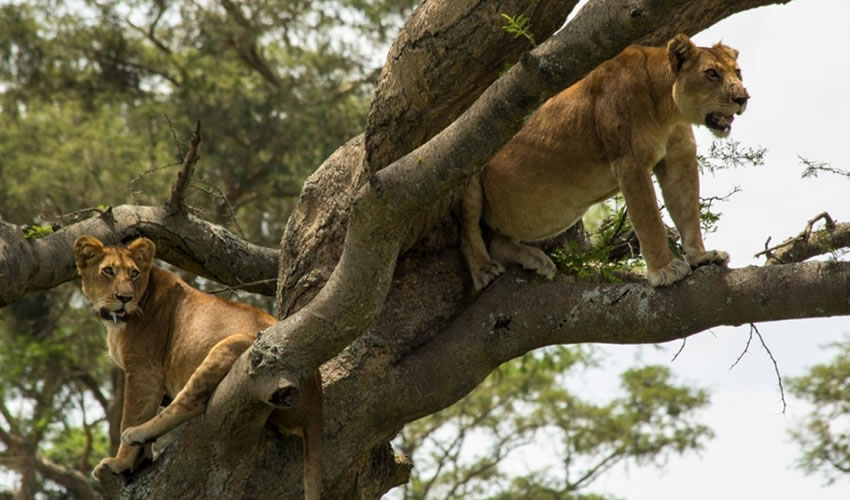
Hamukungu village which is neighbouring the park and offers local community experiences and boat rides on Lake George have seen an increase in lion conflicts given that they share the same land with wildlife. For instance, a pride of 5 lions and 7 cubs was recently found dead due to suspected poisoning, a tactic that locals use to reiterate when predators kill their livestock or attack people’s homes. Snaring is also another illegal tool used by poachers who set traps targeting small and mid-sized antelopes.
The traps end up catching lions of which 1 adult female lion whose leg was amputated leading to suffering and death a few years later. In this regard, the Lion Research activity, a project under the Uganda Carnivore Program brings together different stakeholders including Uganda Conservation Foundation (UCF) to address threats to lions in Uganda.
Lion tracking permit cost is $100 per person available through UWA or tour operator. According to Uganda (WCS), each lion in Queen Elizabeth national park generates over $13,500 annually, making a significant contribution to Uganda’s economy. Through their control over the population of herbivores, lions are not only essential to the ecology but also to the local economy. Each lion in Queen Elizabeth National Park, according to WCS, generates over $13,500 annually, significantly boosting Uganda’s economy. They need to be safeguarded for future generations.
Chimpanzee research expeditions
Uganda is home to over 5,000 chimpanzees of which 13 primate species including over 1,500 are found in Kibale forest national park alone and 600 in the Budongo forest reserve. Chimpanzee trekking safaris in the two places not only offer higher chances to see man’s closest relatives in the wild but also opportunities for chimpanzee research and habituation experiences. Elsewhere in addition, chimp treks are also available in Kyambura gorge and Kalinzu forest wildlife reserves, which are found within Queen Elizabeth national park.
Chimpanzees mainly live in dense primary tropical rainforest habitats across western Uganda. They are omnivorous creatures that eat both plants and animal flesh and are known to share 98.5% of our DNA. They consume 50% fruits, seeds, leaves, and flowers in their diet. For protein, they also consume mushrooms, insects, and small animals. Depending on their home ranges, chimpanzees can move in pursuit of food over an area of 6 to 70 sq. km.
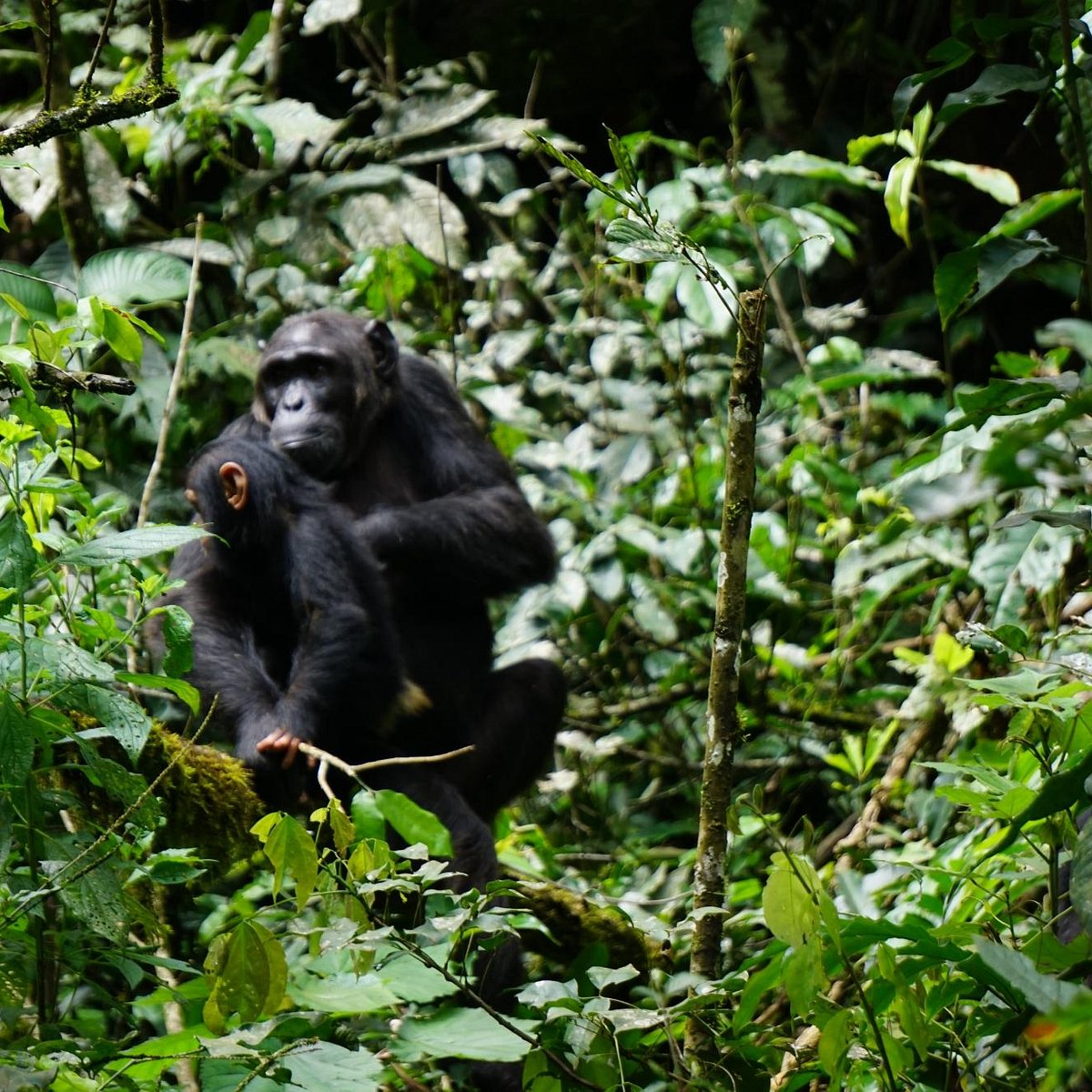
Therefore, any alterations in their food patterns is likely to have an impact on how they feed. While habitat loss, and poaching pose the greatest threats to chimpanzees, climate change is also influencing the fruiting seasons. Recent study by the Earth Watch Institute and information currently available indicate that the Budongo Forest Reserve’s fruit production may be declining due to climate change. As a result, chimpanzees end up marauding into the adjacent local farmlands raiding crops which can cause human wildlife conflict. As a result, chimpanzees end up marauding into the nearby local farms and crop raids – a cause for human wildlife conflicts.
Investigating the reasons behind the shift in fruiting seasons, Earth Watch is working with UWA and conservationists to find answers and support local communities. Whether you’re simply traveling for safari or searching for volunteering opportunities in Uganda, tours for chimpanzee research are now available for booking through tour operators. Visitors will be able to track and see chimps in Budongo while assisting in collection of data on primate feeding behavior.
Giraffe and elephant research
African elephants are critically endangered species and therefore are in grave danger of going extinct. More than 5,000 elephants live in Uganda, mostly in the Kidepo, Murchison Falls, and Queen Elizabeth national parks. Murchison falls conservation area is a key protected area with over 1,330 elephants and over 1,450 of the 1,575 Nubian giraffes in Uganda, which is almost 50% of the total Nubian giraffe population in Africa.
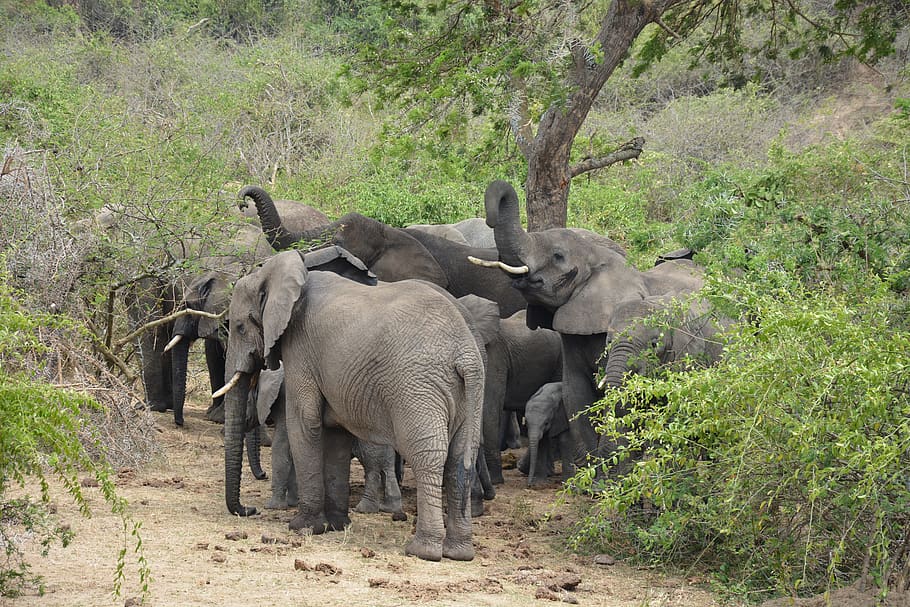
Elephants and giraffes have become the focus of study as a result of the beginning of oil and gas exploration on the shores of Lake Albert, which is located on the park’s northern edge. A thorough analysis of the species is being conducted by the Uganda Conservation Foundation in collaboration with the Giraffe Conservation Foundation, UWA, and other collaborators. Travellers have the chance to take part in giraffe and elephant study expeditions. Additionally, there is a honeymoon trail south of the Nile River where tourists can go on foot with a ranger to see giraffes and elephants.
The need to conserve wildlife is paramount not only to safeguard biodiversity and prevent extinction of species but also to save humans. Since nature gives oxygen, food, water, and many ecosystem services in abundance, it is impossible for humans to survive without preserving it. Wildlife is a big tourist attraction in countries where the development of ecotourism in protected areas generates revenue for local economic development.

